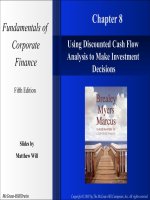Fundamentals of corporate finance 10e ROSS JORDAN chap004
Bạn đang xem bản rút gọn của tài liệu. Xem và tải ngay bản đầy đủ của tài liệu tại đây (1.11 MB, 53 trang )
Chapter 4
Long-Term Financial Planning and Growth
4-1
McGraw-Hill/Irwin
Copyright © 2013 by The McGraw-Hill Companies, Inc. All rights reserved.
Chapter Outline
•
What is Financial Planning?
•
Financial Planning Models
•
The Percentage of Sales Approach
•
External Financing and Growth
•
Some Caveats Regarding
Financial Planning Models
4-2
Chapter Outline
•
What is Financial Planning?
•
Financial Planning Models
•
The Percentage of Sales Approach
•
External Financing and Growth
•
Some Caveats Regarding
Financial Planning Models
4-3
Elements of Financial Planning
•
Investment in new assets – determined by capital
budgeting decisions
•
Degree of financial leverage – determined by capital
structure decisions
•
Cash paid to shareholders – determined by dividend
policy decisions
•
Liquidity requirements – determined by net working
capital decisions
4-4
Financial Planning Process
•
Planning Horizon - divide decisions
into short-run decisions (usually
next 12 months) and long-run
decisions (usually 2 – 5 years)
•
Aggregation - combine capital
budgeting decisions into one large
project
4-5
Financial Planning Process
Assumptions and Scenarios
•
Make realistic assumptions about
important variables
•
Run several scenarios where you
vary the assumptions by
reasonable amounts
•
Determine, at a minimum, worst
case, normal case, and best case
scenarios
4-6
Role of Financial Planning
• Examine interactions – help
management see the interactions
between decisions
• Explore options – give management a
systematic framework for exploring
its opportunities
4-7
Role of Financial Planning
•
Avoid surprises – help management identify possible outcomes
and plan accordingly
•
Ensure feasibility and internal consistency – help management
determine if goals can be accomplished and if the various stated
(and unstated) goals of the firm are consistent with one another
4-8
Chapter Outline
•
What is Financial Planning?
•
Financial Planning Models
•
The Percentage of Sales Approach
•
External Financing and Growth
•
Some Caveats Regarding
Financial Planning Models
4-9
Financial Planning Model Ingredients
•
Sales Forecast – many cash flows
depend directly on the level of
sales (often estimated using sales
growth rate)
•
Pro Forma Statements – setting up
the plan using projected financial
statements allows for consistency
and ease of interpretation
4-10
Financial Planning Model Ingredients
•
Asset Requirements
the additional assets that will be required to meet sales
projections
•
Financial Requirements the amount of financing needed to
pay for the required assets
4-11
Financial Planning Model Ingredients
•
Plug Variable determined by
management deciding what type of
financing
will be used to make the balance
sheet balance
•
Economic Assumptions explicit
assumptions about the coming
economic environment
4-12
Example I:
Constructing a Pro Forma
The Current Balance Sheet
Gourmet Coffee Inc.
Balance Sheet
December 31, 2011
Assets
1000 Debt
Equity
Total
4-13
1000 Total
400
600
1000
Example I:
Constructing a Pro Forma
The Current Income Statement
Gourmet Coffee Inc.
Income Statement
For Year Ended
December 31, 2011
Revenues
4-14
2000
Less: costs
(1600)
Net Income
400
Example I:
Constructing a Pro Forma
Initial Assumptions:
•
Revenues will grow at 15%
(2,000*1.15)
•
All items are tied directly to sales, and the current
relationships are optimal
•
4-15
Consequently, all other items will also grow at 15%
Example I: Constructing a Pro Forma
Income Statement
Gourmet Coffee Incorporated
Pro Forma Income Statement
For the Year Ended 2012
2011
Forecasted growth
Pro forma 2012
rate
4-16
Revenues
2,000
1.15
2,300
Less: costs
1600
1.15
(1,840)
Net Income
400
1.15
460
Example I: Constructing a Pro Forma
Balance Sheet
Gourmet Coffee Incorporated
Pro Forma Balance Sheet
December 31, 2012
2011
Total Assets
Pro forma 2012
1,000
1.15
1,150
Total Debt
400
1.15
460
Equity
600
1.15
690
Total Liab + OE
4-17
Forecasted growth
1,150
Example I: Constructing a Pro Forma
Balance Sheet
Gourmet Coffee Incorporated
Pro Forma Balance Sheet
December 31, 2012
2011
Total Assets
Pro forma 2012
1,000
1.15
1,150
Total Debt
400
1.15
90
Equity
600
1.15
1,060
Total Liab. + OE
4-18
Forecasted growth
1,150
Chapter Outline
•
What is Financial Planning?
•
Financial Planning Models
•
The Percentage of Sales Approach
•
External Financing and Growth
•
Some Caveats Regarding
Financial Planning Models
4-19
Percentage of Sales Approach
Income Statement
•
Costs may vary directly with sales - if this is the case,
then the profit margin is constant
•
Depreciation and interest expense may not vary
directly with sales – if this is the case, then the profit
margin is not constant
4-20
Percentage of Sales Approach
Income Statement
•
Dividends are a management decision and generally
do not vary directly with sales – this influences
additions to retained earnings
4-21
Example II: % of Sales Pro Forma
Income Statement
Tasha’s Toy Emporium
Tasha’s Toy Emporium
Pro Forma Income Statement, 2012
Income Statement, 2011
% of Sales
Sales
5,000
Less: costs
60%
EBT
2,000
40%
Less: taxes (40% of
(800)
16%
EBT)
4-22
1,200
5,500
Less: costs
(3,000)
Net Income
Sales
(3,300)
EBT
2,200
Less: taxes
(880)
Net Income
1,320
24%
Dividends
600
Dividends
660
Add. To RE
600
Add. To RE
660
Percentage of Sales Approach
Balance Sheet
• Initially assume all assets, including fixed, vary
directly with sales
• Accounts payable will also normally vary
directly with sales
4-23
Percentage of Sales Approach
Balance Sheet
•
Notes payable, long-term debt and equity
generally do not vary directly with sales
because they depend on management
decisions about capital structure
•
The change in the retained earnings portion of
equity will come from the dividend decision
4-24
Example II: % of Sales Pro Forma
Balance Sheet
Tasha’s Toy Emporium – Balance Sheet
Current
% of Sales
Pro Forma
Current
ASSETS
Pro Forma
Liabilities & Owners’ Equity
Current Assets
Current Liabilities
Cash
$500
10%
$550
A/P
$900
18%
$990
A/R
2,000
40
2,200
N/P
2,500
n/a
2,500
Inventory
3,000
60
3,300
Total
3,400
n/a
3,490
5,500
110
6,050
LT Debt
2,000
n/a
2,000
CS & APIC
2,000
n/a
2,000
RE
2,100
n/a
2,760
4,100
n/a
4,760
Total
Fixed Assets
Owners’ Equity
Net PP&E
4,000
80
4,400
Total Assets
9,500
190
10,450
Total
Total L & OE
4-25
% of Sales
9,500
10,250









